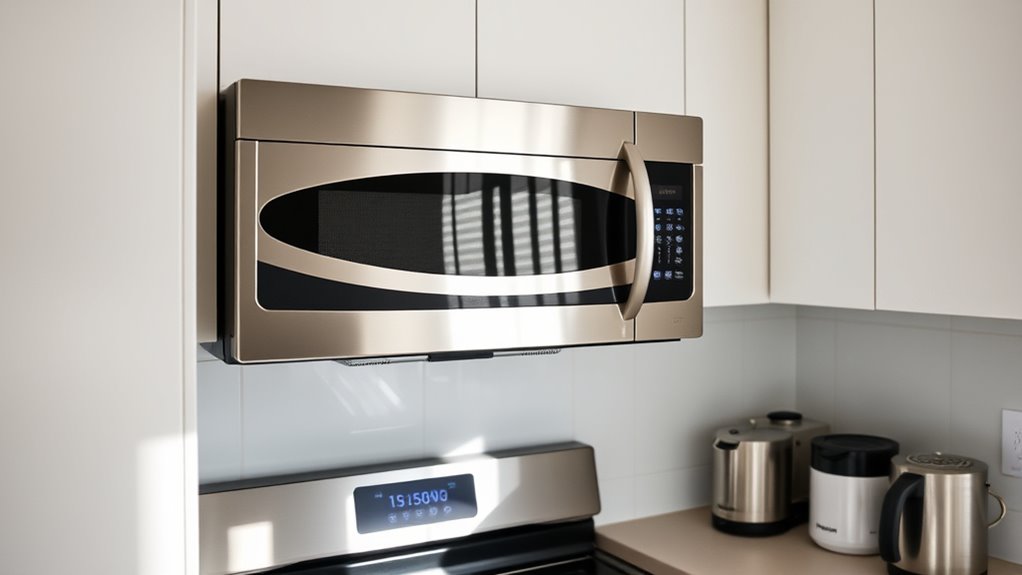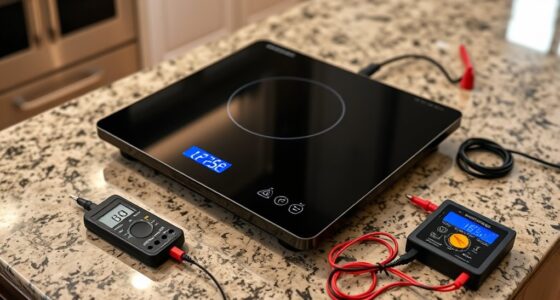Over‑the‑range microwaves save space by mounting above your stove, making small kitchens look less cluttered and more organized. They combine microwave and venting functions, which enhances efficiency but can limit interior capacity for large dishes. Installation requires considering cabinet support and ventilation needs, while modern designs add sleek, aesthetic appeal. Budget options are available, but noise levels and maintenance can be drawbacks. Want to discover how to choose the best fit for your kitchen? Keep exploring for more details.
Key Takeaways
- Space-saving design frees up valuable countertop and cabinet space in small kitchens.
- Integrated ventilation and microwave functions streamline cooking, reducing clutter and enhancing efficiency.
- Compact size may limit cooking capacity, making it less suitable for large or multiple dishes.
- Modern models offer sleek aesthetics that improve kitchen style and organization.
- Installation and ventilation requirements require careful planning to ensure safety and proper fit.
Space-Saving Benefits in Compact Kitchens

Over‑the‑range microwaves are ideal for compact kitchens because they free up valuable counter space. Instead of a bulky microwave sitting on your countertop, it mounts above your stove, making your kitchen look less cluttered and more organized. This setup is perfect for small kitchens where every inch counts. It combines cooking and reheating functions in one unit without sacrificing valuable workspace. By installing the microwave overhead, you create more room for food prep, small appliances, or decorative items. Plus, the streamlined design minimizes clutter, giving your kitchen a cleaner, more open feel. This efficient use of vertical space makes over-the-range microwaves a popular choice among those with limited kitchen re‑space, and the integration of appliance technology can also maximize kitchen efficiency, which is essential in tight spaces. Additionally, many models now include features like sensor cooking that enhance overall functionality.
Multifunctionality: Combining Microwave and Ventilation
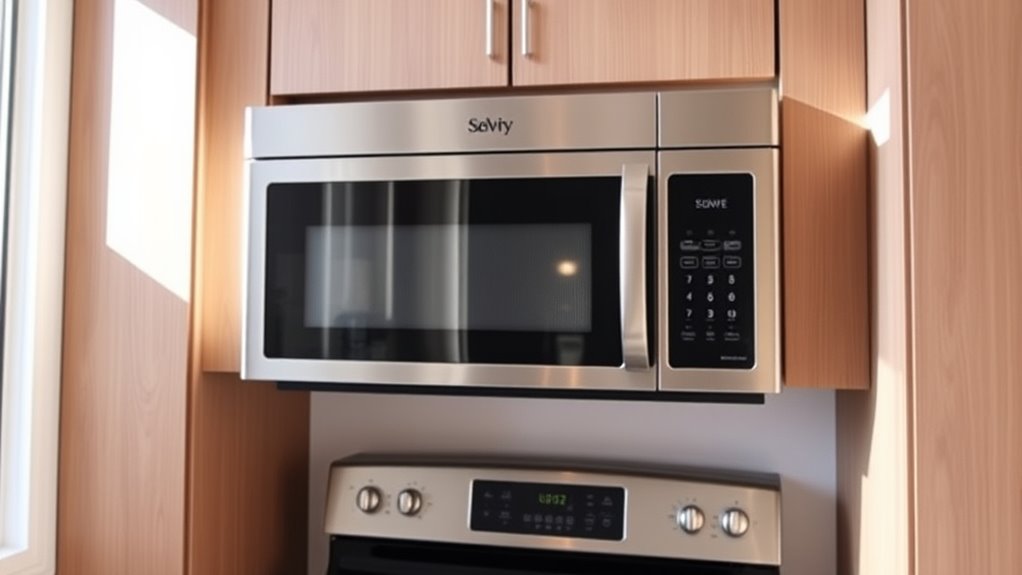
By integrating microwave and ventilation functions into a single unit, you maximize the efficiency of your kitchen space. This combination allows you to cook and vent smoke, steam, and odors without needing separate appliances. It saves countertop or cabinet space, which is especially valuable in small kitchens. Multifunctional units streamline your cooking process, reducing clutter and making cleanup easier. Many models feature powerful exhaust fans that effectively remove cooking fumes while providing quick microwave heating. Additionally, these units often come with smart controls and intuitive interfaces, making operation simple. Incorporating ventilation systems enhances air quality and comfort during cooking. With everything in one appliance, you also reduce the number of devices you need to maintain and repair. For highlighted or color-treated hair, using a specialized shampoo can help preserve color vibrancy and shine, further enhancing your kitchen’s multifunctionality by maintaining your hair’s health while cooking. Incorporating compact kitchen appliances can further optimize space utilization and efficiency. A well-designed multifunctional unit can also support space-saving solutions, making it an ideal choice for small kitchens. Furthermore, selecting models with adjustable ventilation options allows you to customize airflow according to your cooking needs. Overall, this multifunctionality enhances your kitchen’s practicality and helps you make the most of limited space.
Installation Considerations and Requirements

Before installing your over-the-range microwave, you’ll need to check if your cabinets are compatible and can support its weight. Make sure the ventilation system meets your needs and that there’s proper airflow. Also, verify that the electrical outlet is correctly positioned for easy connection and safety. Additionally, ensure that your installation complies with local building codes and permits to avoid potential legal issues. Monitoring for smart appliance compatibility can also improve safety and functionality. For small kitchens, considering space-saving designs can maximize efficiency and ease of use. Furthermore, assessing the weight capacity of your cabinetry ensures secure installation and long-term durability. Staying informed about hackathons can provide innovative solutions for home improvement projects and smart kitchen integrations.
Cabinet Compatibility Requirements
Ensuring your cabinetry can accommodate an over-the-range microwave is essential for a safe and secure installation. Check that your cabinets are sturdy enough to support the weight of the microwave, which can be quite heavy. Measure the available space carefully, including height, width, and depth, to ensure the unit fits comfortably without obstructing other appliances or storage. Your cabinets should be level and secure, capable of handling additional weight and vibrations during operation. If your existing cabinetry isn’t designed for this purpose, you may need to reinforce or modify it before installation. Avoid using cabinets that are too flimsy or shallow, as they could pose safety risks or lead to instability. Proper preparation ensures your microwave stays securely in place and functions safely. Additionally, considering self-watering plant pots can be an example of selecting functional and durable cabinetry materials for your kitchen. Also, evaluating filtration systems can help ensure your cabinetry materials are resistant to moisture and spills, enhancing durability over time. When selecting cabinetry, it is also advisable to review electric bike specifications, as understanding weight capacities and structural requirements can help in planning for heavy appliances like over-the-range microwaves.
Ventilation System Needs
Proper ventilation is key to maintaining safe and efficient operation of your over-the-range microwave. You’ll need to take into account whether your kitchen can support venting options—either ducted or ductless. Ducted systems require a vent pipe leading outside, which can involve significant installation work, especially in small kitchens. Ductless models, on the other hand, use filters to recirculate air, making installation easier but sometimes less effective at removing smoke and odors. Make sure your microwave’s ventilation needs match your kitchen’s setup and your lifestyle. Check the specifications for airflow capacity, measured in CFM (cubic feet per minute), to verify it’s sufficient for your cooking habits. Proper installation guarantees effective removal of smoke, steam, and odors, keeping your small kitchen comfortable and safe.
Electrical Outlet Placement
To guarantee your over-the-range microwave functions safely and efficiently, you need to pay close attention to the placement of the electrical outlet. Ideally, the outlet should be installed directly above or behind where the microwave will sit. This keeps cords hidden and reduces tripping hazards. Make sure the outlet can handle the microwave’s power requirements, typically 120V with a dedicated circuit. If you’re remodeling, plan outlet placement early to avoid awkward wiring later. Use the table below to understand key considerations:
| Placement Tip | Benefit |
|---|---|
| Behind or above microwave | Keeps cords out of sight and prevents clutter |
| Dedicated circuit outlet | Ensures safe, reliable power without overloads |
| Easy access for unplugging | Simplifies maintenance and emergency disconnection |
Aesthetic Appeal and Modern Design

Over-the-range microwaves seamlessly blend functionality with sleek design, making them a stylish addition to any kitchen. Their streamlined appearance helps maximize space while maintaining a modern look. Many models feature clean lines, smooth surfaces, and matching finishes that complement contemporary appliances. You can choose from stainless steel, black, or white finishes, allowing you to match your kitchen’s color scheme effortlessly. Some designs incorporate touch controls and digital displays that add a high-tech feel. The built-in look creates a seamless, uncluttered appearance on your countertops. Overall, these microwaves enhance your kitchen’s aesthetic, making your space feel more polished and organized. Their modern design not only looks good but also elevates your kitchen’s overall style and appeal.
Cost Factors and Budget-Friendly Options
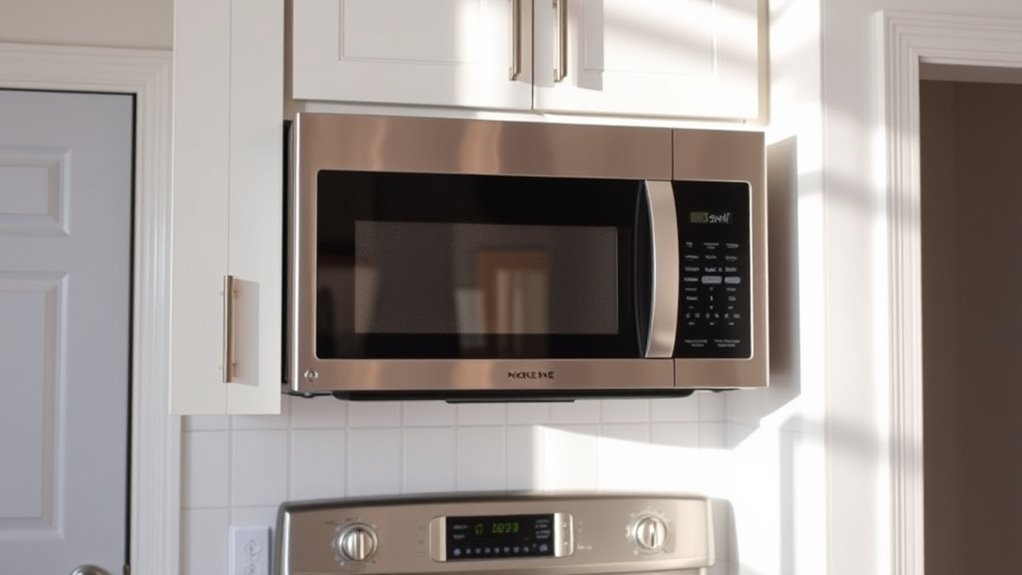
When shopping for over-the-range microwaves, you’ll notice a wide price range that can fit different budgets. You can find affordable models that still offer great features, especially when you look for deals or discounts. Knowing your options helps you choose a microwave that balances cost and quality effectively.
Price Range Variability
The price of over-the-range microwaves can vary widely based on features, brand reputation, and size. Higher-end models with advanced sensors or sleek designs tend to cost more, while basic units are budget-friendly. To understand this better, consider the following:
| Feature Level | Price Range | Ideal For |
|---|---|---|
| Basic | $150 – $250 | Small kitchens, minimal use |
| Mid-Range | $250 – $400 | Regular use, extra features |
| Premium | $400 – $700+ | High-end designs, advanced tech |
This table shows that your budget determines what features you get, but there’s usually a model that fits your needs without overspending.
Affordable Models and Deals
Finding an affordable microwave that still meets your needs is easier than you might think. Many brands offer budget-friendly models with essential features, making it possible to find a reliable over-the-range microwave without overspending. Keep an eye out for sales, especially during holiday seasons or big retail events, where discounts can considerably lower prices. Consider refurbished or gently used units from reputable sellers—these often come with warranties and offer great savings. Shopping online can also help you compare prices and read reviews to ensure you’re getting good value. Focus on models that balance cost with durability and functionality, like those with standard power levels and straightforward controls. With a little patience and research, you’ll find a deal that fits your budget and your kitchen needs.
Accessibility and Ease of Use
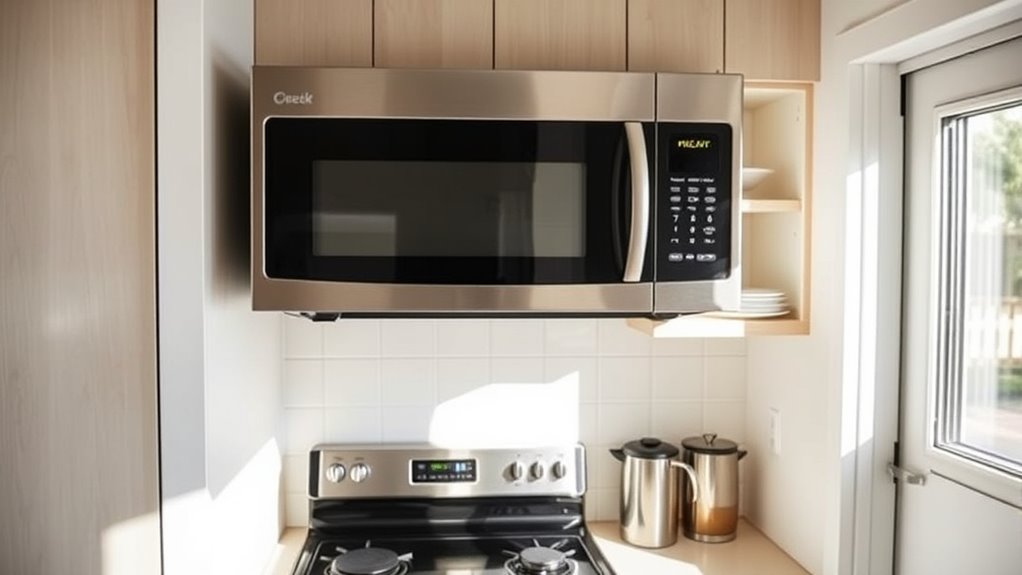
Over‑the‑range microwaves are designed to be user-friendly, making everyday cooking more convenient. They typically feature intuitive controls that simplify operation. For example, you can quickly:
- Use preset buttons for common tasks like popcorn or reheating.
- Adjust power levels easily with straightforward dials or touchscreens.
- Access the microwave’s features without needing to bend down or reach high, thanks to ergonomic placement.
Additionally, many models include clear displays and tactile buttons, helping you navigate settings effortlessly. This makes them suitable for all users, including those with limited mobility or dexterity. Overall, their design prioritizes accessibility and ease of use, ensuring you can operate your microwave confidently and efficiently every day.
Noise Levels and Ventilation Effectiveness
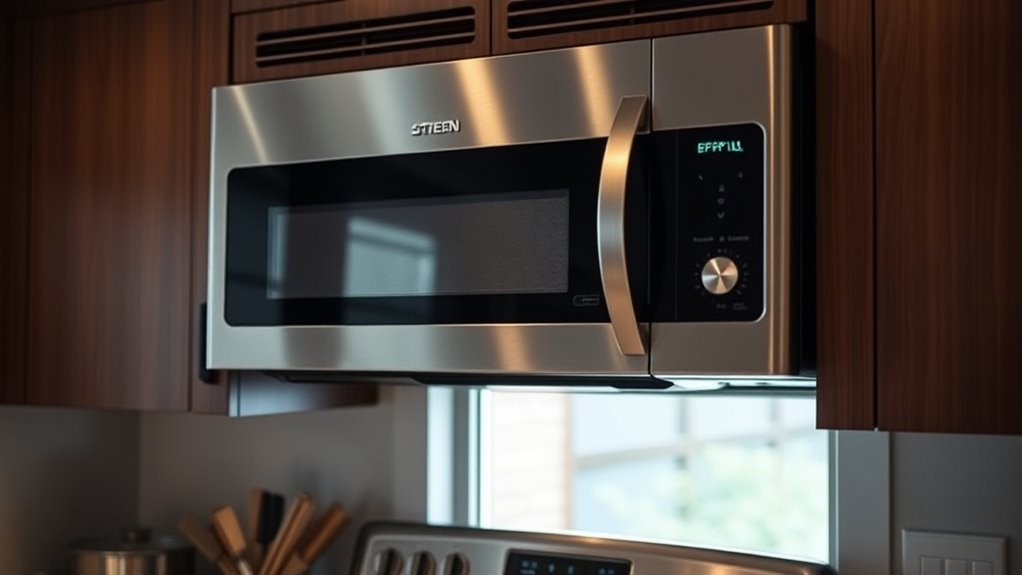
You’ll want to evaluate how loud your microwave operates and how well its ventilation system works. Comparing noise levels helps you choose a quieter model, while gauging ventilation power ensures your kitchen stays fresh. Features like sound insulation can make a big difference in creating a more comfortable cooking environment.
Noise Level Comparison
Have you ever wondered how noise levels compare when using different over-the-range microwaves? Noise varies considerably across models, affecting your kitchen’s comfort. Generally, quieter units operate around 50-60 decibels, while louder ones can reach 70 decibels or more. Consider these points:
- Higher wattage models typically produce more noise during operation.
- Built-in noise reduction features can lower sound levels by a few decibels.
- Ventilation systems may add to overall noise, especially when running at high power.
When choosing, think about how often you’ll use the microwave and your tolerance for noise. A quieter microwave makes for a more peaceful cooking environment, especially in small kitchens.
Ventilation Power Efficiency
While higher ventilation power can improve air circulation and remove smoke or odors more effectively, it often comes with increased noise levels. You’ll notice that boosting the fan speed makes the vent work harder, but it also generates louder sounds. This can be distracting during cooking or when you’re trying to enjoy a quiet meal. However, increased ventilation power means better removal of steam, grease, and smells, which keeps your small kitchen cleaner and fresher. Some models balance power and noise efficiently, offering strong airflow without excessive noise. To maximize ventilation effectiveness, look for units with multiple fan speeds and high airflow ratings. Ultimately, finding the right balance between power and noise depends on your cooking habits and your tolerance for sound.
Sound Insulation Features
Sound insulation features play a crucial role in controlling noise levels and enhancing ventilation effectiveness in over-the-range microwaves. When choosing a unit, pay attention to its soundproofing capabilities, as they directly impact your kitchen experience. Better insulation reduces the noise during operation, making mealtime less disruptive. Ventilation systems with effective soundproofing also minimize noise from fan and exhaust sounds. To evaluate sound insulation, consider these factors:
- The material quality of the microwave’s casing
- The design of the ventilation system to dampen noise
- The presence of soundproofing features like insulated panels or noise-reducing fans
A well-insulated microwave ensures quieter operation and more efficient ventilation, especially important in small kitchens where noise can easily become overwhelming.
Maintenance and Cleaning Challenges
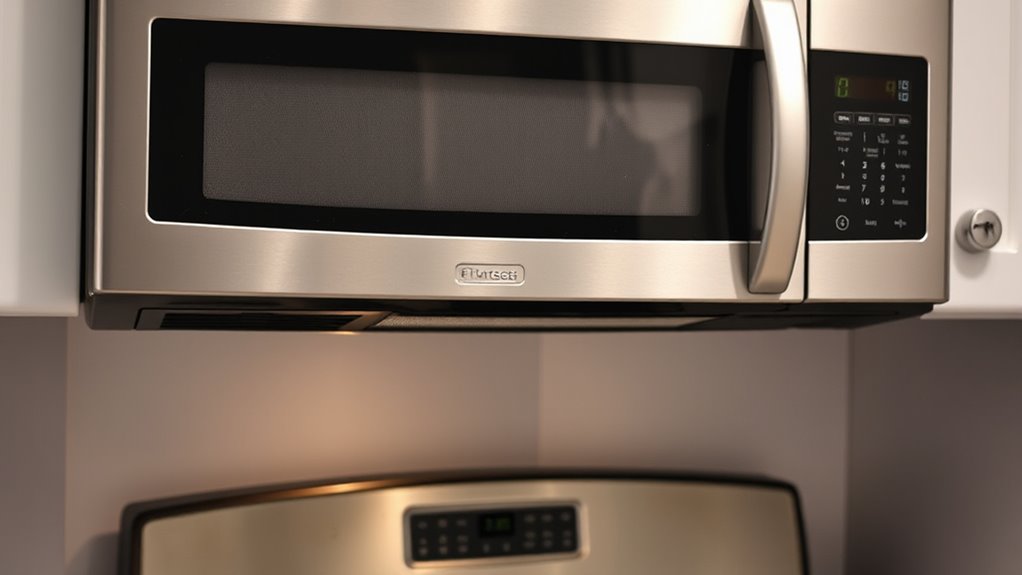
Over-the-range microwaves can be convenient, but they often present unique maintenance and cleaning challenges. Since they’re mounted above your stove, grease, splatters, and food spills tend to accumulate quickly on the microwave surface and vent filters. Cleaning these areas requires regular attention to prevent buildup that can affect performance and hygiene. The vent filters need periodic removal and thorough cleaning, which can be tricky in tight spaces or if the filters are hard to access. Additionally, the microwave’s interior can be difficult to reach, making it hard to remove stubborn stains or crumbs. You also need to be cautious when cleaning around the controls and display, avoiding excess moisture that could damage internal components. Staying consistent with maintenance guarantees your microwave stays functional and looks good longer.
Potential Limitations in Cooking Capacity
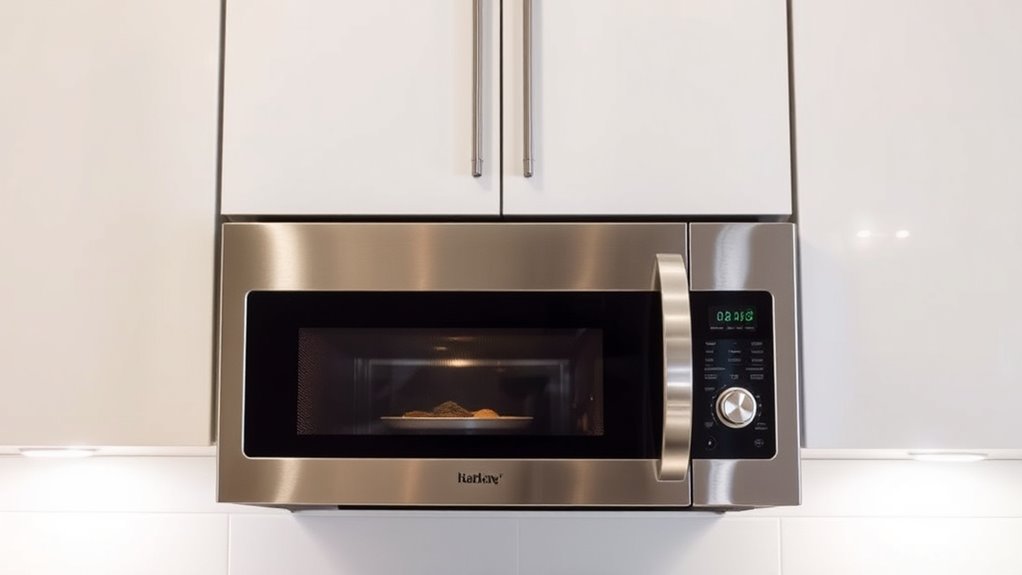
Over-the-range microwaves often have limited cooking capacity compared to standalone models due to their compact size. This means you can’t cook large or multiple dishes at once, which may slow down meal prep. You might encounter issues like:
- Smaller turntables that can’t accommodate big plates or pans.
- Reduced interior space, limiting the size of containers you can use.
- Shorter cooking times for larger portions, requiring multiple cycles.
Because of these constraints, you might find yourself reheating or cooking in smaller batches. If you regularly prepare large meals or use oversized cookware, these capacity limitations could impact your convenience. It’s essential to contemplate your typical cooking needs before choosing an over-the-range microwave for your small kitchen.
Safety Features and Usage Precautions

Because microwave ovens involve high-powered electromagnetic waves, safety features are essential to prevent accidents and guarantee proper use. Many over-the-range models include features like child safety locks, which prevent kids from accidentally operating the microwave. Overheat protection sensors automatically shut off the unit if it detects excessive heat, reducing fire risk. Additionally, interlock switches ensure the microwave only runs when the door is securely closed. To stay safe, always read the user manual and follow recommended usage instructions. Avoid operating the microwave with damaged doors or seals, and never tamper with safety devices. Regularly clean the vents and check for any signs of damage. Using these safety features properly minimizes risks and helps you enjoy the convenience of your microwave confidently.
Frequently Asked Questions
How Energy-Efficient Are Over-The-Range Microwaves Compared to Countertop Models?
You wonder how energy-efficient over-the-range microwaves are compared to countertop models. Generally, over-the-range units use slightly more energy because they have built-in ventilation and lighting, which adds to their power consumption. However, they’re still quite efficient since they heat food quickly and don’t waste energy like traditional ovens. If you want to save energy, choose models with high efficiency ratings and features like sensor cooking.
Can Over-The-Range Microwaves Be Used With Different Kitchen Cabinet Heights?
You can use over-the-range microwaves with different cabinet heights, but it requires careful measurement and possibly custom installation. Standard models typically fit standard cabinet heights, but if your cabinets are taller or shorter, you might need an adjustable mount or custom brackets. Always check the microwave’s specifications and consult a professional installer to guarantee proper fit and safe operation, avoiding any potential hazards or damage.
What Are Common Troubleshooting Issues With Over-The-Range Microwave Vents?
Imagine your microwave vent as a vigilant guardian, clearing smoke and odors like a steadfast lighthouse. Common issues include poor ventilation, which feels like a clogged river, and noisy operation, akin to a grumbling engine. Sometimes, the vent switch or filters are the culprits, blocking airflow. Regularly clean filters, check switches, and guarantee proper installation to keep your microwave’s vent running smoothly, guiding your kitchen’s air with ease.
Are There Specific Brands Known for Durability in Small Kitchen Models?
When choosing a microwave for your small kitchen, you want durability you can rely on. Brands like Panasonic, Samsung, and LG are known for their sturdy models that last longer and handle daily use well. You’ll find these brands offer reliable performance, quality construction, and good warranties. Do some research on specific models to ensure they fit your space and meet your needs, so you get the best value and longevity.
How Do Over-The-Range Microwaves Affect Overall Kitchen Resale Value?
Imagine your kitchen as a movie set, with that over-the-range microwave as the star. It can boost resale value if it’s sleek, modern, and in good working order, catching buyers’ eyes. But if it’s outdated or bulky, it might turn them off faster than a bad script. So, choose wisely—your microwave’s style and condition could be the plot twist that ups your home’s appeal.
Conclusion
Choosing an over-the-range microwave transforms your small kitchen into a sleek, space-efficient haven—like fitting a spaceship into a shoebox! While it offers incredible convenience and style, consider installation, capacity, and noise factors. If you weigh these pros and cons carefully, you’ll turn your compact space into a culinary command center. Embrace this smart upgrade and enjoy cooking with ease—your kitchen will thank you for it, and so will your sanity!
